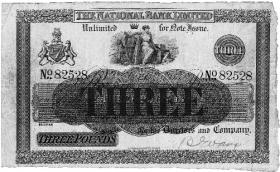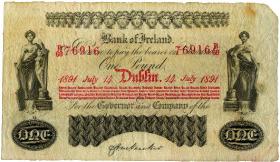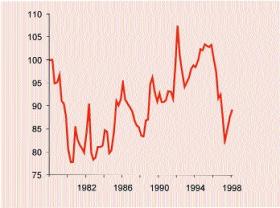Using Other People’s Money: Farewell to the Irish Pound
Published in 20th-century / Contemporary History, Features, Issue 1 (Spring 2002), Medieval History (pre-1500), Volume 10
A 1913 National Bank three pound note. (Bank of Ireland)
With the removal of its legal tender status after 9 February 2002, the Irish pound slides into probable oblivion. Its existence can be said to have begun in 1460, when the assertive Drogheda parliament unilaterally reduced by 20 per cent the silver content of the penny in Ireland. There were no pound coins yet in those days, much less pound notes: to define the penny was to define the pound.
In its first 250 years Irish coinage more or less held its own on average against sterling, but like the latter, suffered many vicissitudes, sometimes in line with England, sometimes not. The silver content of the coins issued for Ireland rose and fell according to the exigencies of state—falling when the Crown (notably Henry VIII, Elizabeth I and James II) leaned on the currency to pay for military and other expenses; rising in response to commercial pressure for a uniform and good quality coinage. It is apparently to Henry that we owe the harp emblem, but this stylistic innovation could not conceal the light silver content of the coins he ordered for Ireland.
Stability came in the eighteenth century. The proclamation of June 1701 fixed the value of the English silver shilling at thirteen pence (1s 1d) Irish, a rate that survived for a century. Since then (as Moore McDowell has observed) the Irish pound has emulated the Cheshire Cat in its tendency almost to vanish behind sterling and then to reappear. Indeed, just twice in the ensuing three centuries did Irish currency re-emerge as a fully autonomous entity: first during the Napoleonic wars, and more recently for the last two decades of the twentieth century when it fluctuated as a member of the European Monetary System (EMS). Lacking a home-grown currency is nothing new for Ireland.
The Georgian pound
Virtually all the silver and gold coins in use in eighteenth-century Ireland were English or Continental, and did not correspond to Irish units. That meant complicated calculations and the use of weighing scales. The fine for late-comers to board meetings at the Bank of Ireland was the odd figure of two shillings eight pence halfpenny (2s. 8 1/2d.); odd, that is, until you realise that this was exactly the value of a half-crown—English of course.
Money did not pervade people’s lives as it does today, and most had little contact with gold and silver. For small payments there was an Irish copper coinage, minted in England and often insufficient in quantity (though in 1724 Mr Wood of Wolverhampton did not get to complete what Dean Swift famously saw as an excessively lucrative contract to supply more copper coins for Ireland).
The official rate or ‘parity’ for silver of thirteen to twelve does not fully describe the rate of exchange in these years. For one thing it was gold, not silver, coins that mattered in the eighteenth century, because the price of gold had been set so high both in Ireland and in England that the use of silver coin diminished—you could do better by melting the silver coins or exporting them to the Continent. Thus the twenty year delay by the Irish authorities before matching Isaac Newton’s 1717 reduction in the sterling value of the gold guinea made the Irish pound relatively cheaper by as much as 2.5 per cent. For the purpose of foreign trade, merchants used bills of exchange, and the rate of exchange for a bill on London could fluctuate, depending on liquidity and credit conditions. (Bills on London were at their most expensive in October 1720 just after the collapse of the South Sea Bubble and the Mississippi Scheme, at about 6 per cent above the thirteen to twelve parity).

An 1891 Bank of Ireland one pound note. (Bank of Ireland)
There were also Irish banknotes, already ‘in good plenty’ as early as 1729. The first of these were issued by the small and often short-lived ‘private’ banks—private in the sense that their shareholders were no more than six in number. But the establishment under statute in 1783 of the Bank of Ireland, a larger joint stock concern loosely modeled on the much earlier Banks of England and of Scotland, opened the modern era of money and banking in Ireland. In return for a substantial loan to the government, not only was the new bank allowed to issue notes, but it was also assured that no other joint stock bank would be allowed to compete.
Bank of Ireland notes denominated in Irish pounds were at first convertible into gold or Bank of England notes at thirteen to twelve. But when convertibility of both banks’ notes was suspended after the brief Napoleonic invasion of Wales in 1797, the value of the two currencies drifted apart. A sharp depreciation of Irish notes in 1803, by about 10 per cent, prompted the establishment of a parliamentary select committee. Apart from revealing that government officials had compensated themselves for losses due to the depreciation, the committee adopted a monetarist view pinpointing the excessive issue of bank notes in Ireland—and not just the adverse balance of payments—as the likely fundamental source of such problems. This was cutting edge stuff and good-ish policy advice, though nowadays scholars doubt that month-to-month exchange rate fluctuations could be fully explained by such a simple theory. Whatever the reason, the fluctuations continued in subsequent years, with the Irish pound briefly (in 1812) going higher than before the suspension—‘Thuas seal, thíos seal’, as T.K. Whitaker put it. It is no wonder that Ulster folk would have nothing to do with paper money in those days: they continued to rely on coin.
With the Act of Union, a separate Irish currency was becoming anomalous. So, although convertibility was restored in 1821 at the old thirteen to twelve rate, just five years later the Irish pound was effectively abolished and replaced by sterling: the banks were closed for three days to allow the laborious conversion of accounts. From then, for over 150 years, there was to be no deviation between the value of Irish and English banknotes.
Irish banknotes in the Victorian era
![Three series of Irish banknotes were issued, initially by the Irish Currency Commission (1928-1943), and thereafter by the Central Bank of Ireland: the ‘A’ series from 1928 to the early 1980s [although the 10s. note went out of circulation in 1971]](/wp-content/uploads/2013/02/Using-Other-People’s-Money-Farewell-to-the-Irish-Pound-3.jpg)
Three series of Irish banknotes were issued, initially by the Irish Currency Commission (1928-1943), and thereafter by the Central Bank of Ireland: the ‘A’ series from 1928 to the early 1980s [although the 10s. note went out of circulation in 1971]
In the 1840s a major overhaul of British monetary thinking and legislation led to a ceiling being placed on the quantity of notes that could be issued by any English bank, other than the Bank of England. The purpose was not to boost the profits of the Bank of England, but to impose a discipline on the overall quantity of notes, as required by monetarist doctrine. Thus, under Peel’s 1844 Bank Charter Act even the Bank of England was allowed to expand its note issue only if the increases were fully backed by gold or silver reserves. Thereafter, as other English banks merged or closed, the number that retained any note-issuing privileges dwindled away.
![the ‘B’ series from 1976 to the early 1990s [£20 note]](/wp-content/uploads/2013/02/Using-Other-People’s-Money-Farewell-to-the-Irish-Pound-4.jpg)
the ‘B’ series from 1976 to the early 1990s [£20 note]
During the latter part of the nineteenth century, note issuing became of secondary importance to the use of cheque-based banking on both sides of the Irish sea. Nevertheless, it was—and is—useful to have a note-issuing privilege: un-issued notes held in the bank’s vaults and tills (and eventually ATMs) did not have to be backed and represented a cheap form of liquid reserve.
By being attached to gold-based sterling in the nineteenth century, Irish money was largely insulated from domestic disturbances. There was no long-term inflation—indeed average prices fell quite steeply in the last quarter of the century—and interest rate movements closely tracked those in London.
The sterling link
![the ‘C’ series from 1992 to 2002 [£100 note]. (Central Bank of Ireland)](/wp-content/uploads/2013/02/Using-Other-People’s-Money-Farewell-to-the-Irish-Pound-5.jpg)
the ‘C’ series from 1992 to 2002 [£100 note]. (Central Bank of Ireland)
The financial conservatism of the early administrations of the Irish Free State is clearly exemplified by the decision to establish a currency commission, on the long-established model of British colonies, rather than a full-fledged central bank. From 1928, the commission issued Irish bank notes in exchange for sterling notes. It undertook to buy-back these notes on a one-for-one basis, and held a full and liquid reserve of sterling and other foreign assets. In a unique, but short-lived arrangement, commercial banks were still allowed to issue notes, though in limited numbers, to a common design, and carrying a guarantee of the currency commission in case the issuing bank should fail. Bank of England notes also circulated freely, as did British coin.
 By 1942, attracted by the international vogue for central banking, a more activist administration had established the Central Bank of Ireland with extensive powers. However, these were, at first, little used and the one-for-one sterling parity of the Irish pound never came under threat. Indeed, such calls that were made for a revision in the parity were generally for an appreciation—for example at the time of the 1949 sterling devaluation, and again when inflation was being imported as a result of sterling weakness in the mid-1970s.
By 1942, attracted by the international vogue for central banking, a more activist administration had established the Central Bank of Ireland with extensive powers. However, these were, at first, little used and the one-for-one sterling parity of the Irish pound never came under threat. Indeed, such calls that were made for a revision in the parity were generally for an appreciation—for example at the time of the 1949 sterling devaluation, and again when inflation was being imported as a result of sterling weakness in the mid-1970s.
Was retaining the sterling link a good idea? It may have blinkered Irish exporters from seeing the opportunities in more dynamic markets further afield. By 1978 the UK still accounted for 47 per cent of Irish exports, though this was less than half the share recorded in 1926. But the sterling link also provided a worthwhile discipline to government policy. Only twice did governments attempt to break away from this discipline. The first was in 1955, when an attempt to hold Irish interest rates down when London rates were rising was followed by a payments crisis that precipitated a deep recession and a surge of emigration. The second was in the late 1970s, when expansionary loan-financed government fiscal policy overheated the economy. This episode could ultimately have threatened the sterling link, but in the event, it was suddenly abandoned for essentially political reasons.
Into Europe
For it was only in 1978, when beckoned to join the EMS, a Franco-German project for a new zone of monetary stability in Europe, that the Irish government decided to make the change. At first there was some hope that it would prove possible to hold the Irish pound’s value at one pound sterling while still respecting the fluctuation limits in the EMS, despite the fact that Britain had not joined the new exchange rate mechanism. But the strength of sterling in the early months of the EMS, buoyed up as it was by North Sea oil revenues and by the tight monetary policy of the Thatcher administration, put paid to that hope. It is arguable that a continuation of the sterling link into the early 1980s would have proved unsupportable anyway, considering the loss of competitiveness it might have entailed at a time of rapidly growing unemployment associated with the fiscal adjustment of those years.
During the twenty years of the EMS, the Irish pound fluctuated widely against sterling, going below 74p. (February 1981) and as high as 110p. (November 1992). Nor was it stable against EMS partner currencies. Realignments in the EMS were fairly frequent, averaging about one a year in the 1980s, and the Irish pound depreciated steadily against the Deutschemark (DM), anchor of the system, reaching a cumulative depreciation of 34 per cent by its low point in 1993. These depreciations both reflected wider weaknesses in the Irish economy in those years, and helped to prevent a loss of competitiveness from compounding those weaknesses. Thus, contrary to the fears of many observers, linking the currency with the DM did not impose an unsupportable discipline, largely because the option of depreciation was readily availed of. By the same token, EMS membership did not help stamp out Irish inflation; though inflation did come down in the 1980s, the reduction lagged behind that of Britain.
Overall, Ireland’s experience of an independent currency in the years of the EMS was not a very happy one. Interest rates were high, giving depositors a return of more than 2 per cent per annum more than would have been available in DM-denominated assets. Implicit in the interest differentials were exaggerated fears of devaluation, especially at times of sterling weakness. High Irish interest rates in the 1980s hampered fiscal adjustment and slowed economic growth.
Perhaps reflecting the chequered experiences of currency independence in Ireland, a sizable 69 per cent majority voted in favour of the Maastricht Treaty establishing inter alia the European Monetary Union (EMU), though voters were probably more swayed by the prospect of more transfers from Brussels. Specialists are more narrowly divided on the issue: though a majority favoured joining the EMU, few expect the net advantages to be substantial. And so it was that, three years ago, management of monetary affairs passed to the European Central Bank and legally speaking the Irish pound was already a denomination of the euro. Now, like the Cheshire Cat, even its smile has faded away.
Based in Dublin, Patrick Honohan is on the staff of the World Bank, where he advises on financial sector policy.
Further reading:
F.W. Fetter, The Irish Pound 1797-1826 (London 1955).
F.G. Hall, The Bank of Ireland 1783-1946 (Dublin 1949).
P. McGowan, Money and Banking in Ireland (Dublin 1990).
M. Moynihan, Currency and Central Banking in Ireland, 1922-1960 (Dublin 1975).
All banknotes reproduced here can be viewed on the website: www.irishpapermoney.com
















